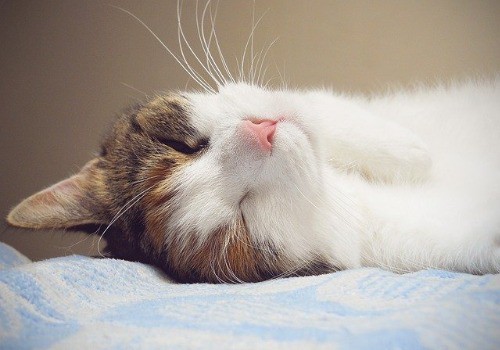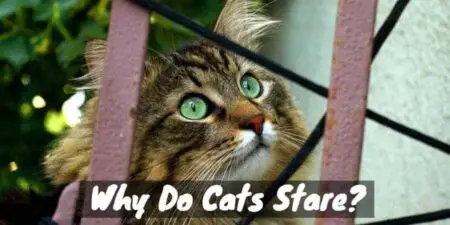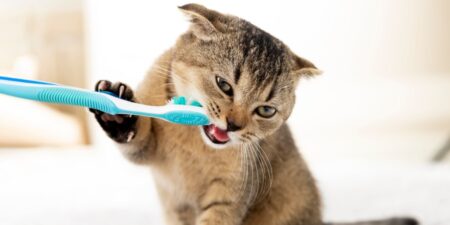When your cat rolls onto its back and looks up at you with its big eyes, it can be hard to handle the cuteness. With its belly on display and its upside-down stare, your cat is rarely more adorable than it is when it’s lying on its back. It’s a position that seems designed just to make you go, “Aww!”
After snapping a quick photo, you reach down to give your cat a belly rub… and you’re met with claws and teeth sinking into your hand. The cuteness from just a second ago is gone; now you’re seeing some of the wild origins of your domestic cat. What was the point of that?
Cats lay on their backs for several reasons, and learning the subtle differences between them could mean the difference between a happy petting and an unpleasant tussle. Let’s find out why cats lay on their backs and learn how to prevent any future misunderstandings.
A Display of Trust

The stomach is one of the most vulnerable parts of a cat’s body. In times of danger, a cat will prioritize the defense of its head and stomach before everything else. With many vital internal organs lying just beyond the cat’s fuzzy belly, the risk of serious injury is much greater than elsewhere.
If your cat is lying on its back with its belly exposed, it may be a sign of submission and trust. A cat displaying vulnerability on its back will also spread its legs open, relax its tail and look up at you with a calm expression. It may purr softly, and if you move your hand towards it, it won’t appear jumpy or begin to flick its tail.
[amazon bestseller=”brush for cat” items=”1″ filter_items=”1″ filterby=”price” filter=”10″ filter_compare=”more” orderby=”price” order=”desc”]
During these displays of vulnerability, your cat feels safe enough around you to allow you access to its stomach, so it may be open to receiving a belly rub. Try to gauge your cat’s temperament as you approach it; if it remains calm, it’s a good sign that you’re invited to pet it. Be gentle and cautious – you don’t want to betray the trust you’re being shown.
Mischievous Intent
Sometimes a cat lays on its back for slightly more sinister reasons. A sudden flop down onto the floor could signal that your feline feels a bit feisty, so read the rest of its body language before getting any closer.
Watch your cat’s tail for a reliable indicator of mood. A tail that flicks back and forth rapidly indicates a heightened state of activity – a good signal that it’s playtime, not petting time. Some cats may even bring their tail between their legs and onto their stomachs to bite and paw at, like a built-in toy.
A cat’s eyes can reveal a lot about its mood – glowing eyes that follow your movements intensely indicate that you’re being targeted. The cat’s paws may twitch, and you might notice it take a few practice swings in your direction. You might hear purring or a series of quick meows: a siren song intended to lure you into the cat’s range.
If your cat is on its back for playtime, it’s wise to avoid putting your hands near it. Though the temptation to try for a belly rub is strong, save it for another time.
Instead, bring out the toys. Wand-style toys and stuffed animals are good choices for this type of play. Just dangle the wand above the cat’s stomach or toss it a soft toy stuffed with catnip and watch the claws come out!
A Relaxing Recline

Every cat has its favorite sleeping position. For some, this means curling up into a tight ball; for others, stretching out on their sides is more comfy. Still, others find that there’s nothing more relaxing than lying on their backs.
[amazon bestseller=”cat sleeping cave” items=”1″ filter_items=”1″ filterby=”price” filter=”0″ filter_compare=”more” orderby=”price” order=”desc”]
Sometimes cats start out sleeping on their sides and roll onto their backs while unconscious. Other times they start out belly-up and get so comfy that they drift off into dreamland. Either way, it’s one of cats’ cutest sleeping positions.
It’s usually pretty easy to tell when a cat on its back is just trying to rest. Its legs will be relaxed, and its eyes will be closed. If it’s asleep, its breathing will be slow, and you might even be able to hear some gentle snoring.
Waking a sleeping cat runs the risk of getting swatted at, even in more protected positions. With its vulnerable stomach revealed, a cat is even more likely to react defensively if roused from its slumber. If your cat is sleeping on its back, it’s best to simply leave it be and wait until it’s awake to give it any attention.
In the Mood for Love
A female cat in heat may lay on her back to indicate that she is ready to mate, especially in the presence of male cats. It’s pretty easy to tell if this is the case, as cats in heat will show many other symptoms of their readiness to mate, such as intense loud vocalizations and a desire to escape the house. Spayed cats do not go into heat, so if your cat is spayed, you can rest assured that she’s not on her back for mating purposes.
It’s best to avoid touching your cat’s stomach if she’s in heat. In this state, she’s highly sensitive and unpredictable; touching her belly could rile her up even more, causing her to scratch or bite you. Save the belly rubs for when she’s out of heat and calmed down.
Defensive Maneuvers
Most of the time, cats won’t show their stomachs if they feel threatened. Occasionally, a cat will lie on its back in a defensive position as if to trick others into approaching it. Whoever falls for this tactic will be clawed with all four paws and likely bitten as well.
If your cat lays down on its back immediately after an uncomfortable or aggravating incident, such as a sudden awakening or an encounter with a pushy dog, it’s probably not in the mood for a belly rub. Rather, it’s priming itself for an attack. Watch the tail for confirmation – if it’s flicking uncontrollably or fluffed up, the cat is definitely not happy.
You can also look for other signs of agitation, such as pushed-back ears, dilated or glowing eyes, and aggressive vocalizations, such as growling or hissing. It’s best to heed the warning signs if any of these are present. Back off for a while and let the cat calm down before approaching it again.
Why Cats Lie on Their Backs When They See You (Video)
"In ancient times cats were worshipped as gods; they have not forgotten this."
-- Terry Pratchett






Thank you, very informative and very helpful.
I have 2 cats, both male. Hurricane Harvey and Kobe.
Cats usually lay on their backs when they’re comfortable around you. It also shows that they love you.
Our car is 13 year old . He wakes me up in the morning by either bitting & pulling my hair or swiping his paw across my face or even nibbling my ear to wake me up so I would go get him his breakfast.
Cats are often seen sleeping in awkward positions like lying on their back, sitting in loaf position, sleeping inside a box etc. It is not common to spot a cat sleeping on its back. Cats rarely sleep like this. What does it mean when a cat lies on its back? A cat’s stomach is the most fragile and vulnerable part of its body. Cats are well aware of this. If your cat feels relaxed and safe around you it will expose its belly and sleep with its leg in awkward positions.
My gal 1.5 yrs old will just flop on the floor, roll over on her back, tuck her paws under her chin aaand sheeeze GONE. Fast asleep. If I move from my position she’ll peek and go to sleep. This is her go to position when family is around. Company she goes into a loaf position. She also has complete access to a screened porch which she will fall asleep out there on her back too. She’s a mess and comfortable with her family for sure. Oh, her bestie is a male Doberman. A gift from above. 😉